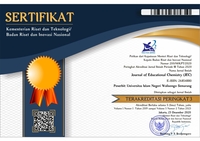Youtube as an Alternative for Distance Learning (DL) Chemistry: Study of Interests and Motivation
DOI:
https://doi.org/10.21580/jec.2021.3.2.8662Keywords:
youtube, distance learning, chemistry, interest, motivationAbstract
This study aims to determine the interests and motivations of students in learning chemistry by utilizing YouTube as an alternative platform in distance learning. This type of research is descriptive quantitative research. Data were obtained from the survey of interest and motivation questionnaires using google forms taken for five weeks during the learning process. The respondents of this study were 100 students majoring in chemistry who studied organic chemistry using YouTube as a distance learning platform. The results showed that youtube as an alternative platform for distance learning (DL) is considered very good for positively impacting students' interest and motivation in studying chemistry. But in its use, it must be accompanied by applications or other media that can support the learning process, especially on material related to the experiment. In addition, in using YouTube, it is necessary to pay attention to aspects such as sound quality, image quality, size of writing, and clarity of the material so that the material presented is easy to understand, straightforward and exciting.Downloads
References
Ahmadi, A. (2007). Psikologi Sosial (2nd ed.). Jakarta: Rineka Cipta.
Anzovino, M. E., & Lowery Bretz, S. (2015). Organic chemistry students' ideas about nucleophiles and electrophiles: The role of charges and mechanisms. Chemistry Education Research and Practice, 16(4), 797–810.
Budiariawan, I. P. (2019). Hubungan Motivasi Belajar Dengan Hasil Belajar Pada Mata Pelajaran Kimia. Jurnal Pendidikan Kimia Indonesia, 3(2), 103.
Delfisanur, Sari, D. Y., Hasanuddin, H., & Ambiyar. (2020). Pengaruh Media Pembelajaran Berbasis Aplikasi YouTube Terhadap Aktivitas dan Hasil Belajar Siswa Kelas X Pada Mata Pelajaran Mesin Konversi Energi di SMK Negeri 1 Koto XI Tarusan. Jurnal Vokasi Mekanika, 2(1), 53–59.
Fitriyani, Y., Fauzi, I., & Sari, M. Z. (2020). Motivasi Belajar Mahasiswa Pada Pembelajaran Daring Selama Pandemik Covid-19. Profesi Pendidikan Dasar, 7(1), 121–132.
Fuady, M. J. (2016). Pengembangan Aplikasi Evaluasi Pembelajaran Online Untuk Pendidikan Jarak Jauh. Tekno, 26, 148–154.
Gopalan, V., Bakar, J. A. A., Zulkifli, A. N., Alwi, A., & Mat, R. C. (2017). A review of the motivation theories in learning. AIP Conference Proceedings, 1–7. AIP Publishing.
Hurlock, E. B. (1978). Perkembangan Anak Jilid 2 (1st ed.). Jakarta: Erlangga.
Jyun, H. Y., & Hong, H. G. (2010). Students' perceptions on chemistry class using youtube video clips. Journal of the Korean Chemical Society, 54(4), 465–470.
Lestari, R. (2013). Penggunaan Youtube sebagai Media Pembelajaran Bahasa Inggris. The Second Progressive and Fun Education Seminar, 607–612. Surakarta.
Liwanag, R. N., Rural, U. P., School, H., Joyce, H., & Ramirez, M. (2019). Teaching Atomic Chemistry To Youtube Generation. Asian Journal of Educational Research, 7(1), 38–49.
Moskowitz, G. B., & Grant, H. (2009). The psychology of goals. In G. B. Moskowitz & H. Grant (Eds.), The Psychology of Goals. New York, NY, US: Guilford Press.
Mujianto, H. (2019). Pemanfaatan Youtube Sebagai Media Ajar Dalam Meningkatkan Minat Dan Motivasi Belajar. Jurnal Komunikasi Hasil Pemikiran Dan Penelitian, 5(1), 135–159.
Munir. (2009). Pembelajaran Jarak Jauh berbasis Teknologi Informasi dan Komunikasi (TIK). Bandung: Alfabeta.
Niswaty, R., & Arhas, S. H. (2019). The Effect of Learning Media on Progress Quality in Office Administration Program in Vocational School Negeri 1 Watampone Bone Regency. Journal of Physics: Conference Series, 1387(1).
Rahmatika, Yusuf, M., & Agung, L. (2021). The Effectiveness of Youtube as an Online Learning Media. Journal of Education Technology, 5(1), 152–158.
Ririn Puspita, T., Niko Kurniawan, L., & Karim, N. (2020). Pemanfaatan Youtube Sebagai Media Pembelajaran Bagi Mahasiswa di Tengah Pandemi Covid-19. Juurnal Komunikasi Masyarakat Dan Keamanan (KOMASKAM), vol.2, No(26556–6125), 1–15.
Safarati, R. N. (2021). Dampak Pembelajaran Daring Terhadap Motivasi. Genta Mulia, 7(1), 113–118.
Slameto. (2010). Belajar dan Faktor-faktor yang Mempengaruhinya (5th ed.). Jakarta: PT. Rineka Cipta.
Smith, D. K. (2014). iTube, YouTube, WeTube: Social Media Videos in Chemistry Education and Outreach. Journal of Chemical Education, 91(10), 1594–1599.
Subagia, I. W. (2014). Paradigma Baru Pembelajaran Kimia SMA. Prosiding Seminar Nasional MIPA UNDIKSHA, 152–163. Singaraja.
Surandika, A., Gunandi, A. A., & Jaya, S. A. (2020, October). Penggunaan Youtube sebagai Media Pembelajaran Jarak Jauh pada Kelas III Sekolah Dasar Islam An – Nizomiyah. Prosiding Seminar Nasional Penelitian LPPM Universitas Muhammadiyah Jakarta, 161–171.
Szeto, E., & Cheng, A. Y. N. (2014). Exploring the Usage of ICT and YouTube for Teaching: A Study of Pre-service Teachers in Hong Kong. Asia-Pacific Education Researcher, 23(1), 53–59.
Uno, H. B. (2007). Teori motivasi dan pengukurannya. JAKARTA: Bumi Aksara.
Wantara, I., Sadia, I., & Suma, I. (2014). Pengaruh Penggunaan Media Video Youtube dalam Pemahaman Konsep Siswa. Jurnal Pendidikan Dan Pembelajaran IPA Indonesia, 4(1), 1–13.
Wigati, S., Sri Rahmawati, D., & Adi Widodo, S. (2018). Pengembangan Youtube Pembelajaran Berbasis Ki Hadjar Dewantara untuk Materi Integral di SMA. Prosiding Seminar Nasional Etnomatnesia, 810–813.
Downloads
Published
How to Cite
Issue
Section
License
The copyright of the received article shall be assigned to the journal as the publisher of the journal. The intended copyright includes the right to publish the article in various forms (including reprints). The journal maintains the publishing rights to the published articles.
Authors are permitted to disseminate published articles by sharing the link/DOI of the article at the journal. Authors are allowed to use their articles for any legal purposes deemed necessary without written permission from the journal with an acknowledgment of initial publication to this journal.

This work is licensed under a Creative Commons Attribution-NonCommercial-ShareAlike 4.0 International License.


